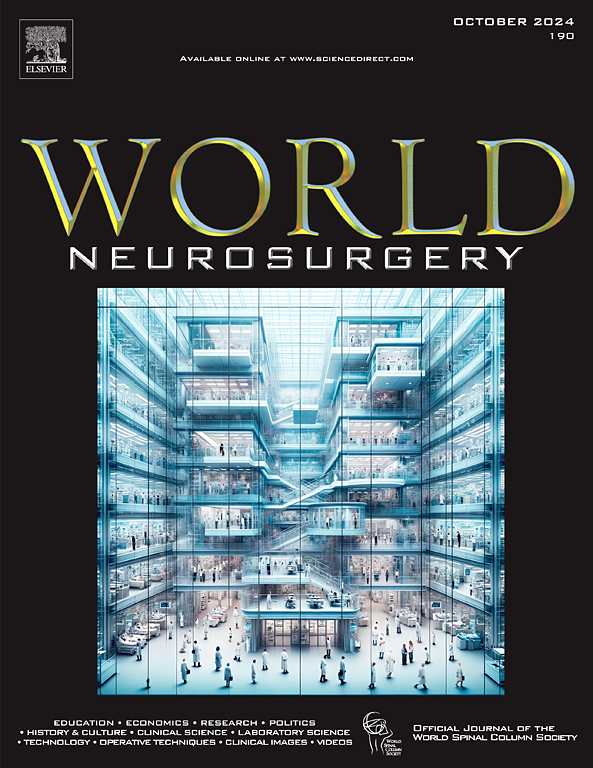Predictive Modeling of Nonfunctioning Giant Pituitary Neuroendocrine Tumor Resection: A Multi-Planar Perspective
IF 1.9
4区 医学
Q3 CLINICAL NEUROLOGY
引用次数: 0
Abstract
Background
Giant pituitary neuroendocrine tumors (GPitNETs) are challenging tumors with low rates of gross total resection (GTR) and high morbidity. Previously reported machine learning (ML) models for prediction of pituitary neuroendocrine tumor extent of resection (EOR) using preoperative imaging included a heterogenous dataset of functional and nonfunctional pituitary neuroendocrine tumors of various sizes leading to variability in results.
Methods
A retrospective study of 100 large nonfunctioning GPitNETs (≥3 cm diameter, >10 cm³ volume) was conducted to develop predictive models for GTR or EOR based on 5 variables: tumor diameter, shape, revised Knosp grade, and modified Hardy classifications for sellar and extrasellar invasion. Model performance was assessed using receiver operating characteristic-area under the curve (AUC) and confusion matrix metrics.
Results
The median preoperative tumor volume was 17.35 cm3 (interquartile range: 12.4–27.0). The median EOR was 97.6% (interquartile range: 84.9–100), and GTR was achieved in 49% of patients. The most predictive variables were the modified Hardy classification for extrasellar extension and Knosp grade (AUC of 0.771 and 0.713, respectively). Among the constructed ML models, the extreme gradient boost algorithm had the highest predictive capability, with an internal validation AUC of 0.86, while the external validation sensitivity, specificity, positive, and negative predictive values were 84%, 77%, 78%, and 82%, respectively.
Conclusions
Utilizing preoperative imaging parameters in a 3-dimensional manner proves highly valuable in predicting the EOR for nonfunctioning GPitNETs. These predictions can be easily calculated using an online open-access application: http://emoryskullbase.shinyapps.io/giant_pituitary_adenoma_resection/.
无功能巨大垂体神经内分泌肿瘤切除的多平面预测模型。
背景:巨大垂体神经内分泌肿瘤(Giant pituitary neuroendocrine tumor, GPitNET)是一种具有挑战性的肿瘤,其总切除率低,发病率高。先前报道的机器学习(ML)模型使用术前成像预测垂体神经内分泌肿瘤切除范围(EOR),包括不同大小的功能性和非功能性垂体神经内分泌肿瘤的异质数据集,导致结果存在差异。目的:建立基于肿瘤多维几何结构的机器学习模型,以准确预测无功能GPitNET的EOR。方法:回顾性研究100例大型无功能GPitNETs(直径≥3cm,体积小于10 cm³),基于5个变量:肿瘤直径、形状、修订Knosp分级和修订的鞍外侵犯Hardy分类,建立GTR或EOR的预测模型。使用ROC-AUC和混淆矩阵指标评估模型性能。结果:术前肿瘤体积中位数为17.35 cm3(IQR: 12.4 ~ 27.0)。中位EOR为97.6% (IQR: 84.9-100), 49%的患者实现了GTR。最具预测性的变量是改良的Hardy鞍外延伸分级和Knosp分级(AUC分别为0.771和0.713)。在构建的ML模型中,XGBoost算法预测能力最高,内部验证AUC为0.86,外部验证敏感性、特异性、阳性预测值、阴性预测值分别为84%、77%、78%和82%。结论:利用术前三维成像参数预测无功能GPitNETs的EOR非常有价值。这些预测可以很容易地通过一个在线开放获取应用程序计算出来:https://anonymousforreview.shinyapps.io/predicted_giant_pituitary_adenoma_resection/。
本文章由计算机程序翻译,如有差异,请以英文原文为准。
求助全文
约1分钟内获得全文
求助全文
来源期刊

World neurosurgery
CLINICAL NEUROLOGY-SURGERY
CiteScore
3.90
自引率
15.00%
发文量
1765
审稿时长
47 days
期刊介绍:
World Neurosurgery has an open access mirror journal World Neurosurgery: X, sharing the same aims and scope, editorial team, submission system and rigorous peer review.
The journal''s mission is to:
-To provide a first-class international forum and a 2-way conduit for dialogue that is relevant to neurosurgeons and providers who care for neurosurgery patients. The categories of the exchanged information include clinical and basic science, as well as global information that provide social, political, educational, economic, cultural or societal insights and knowledge that are of significance and relevance to worldwide neurosurgery patient care.
-To act as a primary intellectual catalyst for the stimulation of creativity, the creation of new knowledge, and the enhancement of quality neurosurgical care worldwide.
-To provide a forum for communication that enriches the lives of all neurosurgeons and their colleagues; and, in so doing, enriches the lives of their patients.
Topics to be addressed in World Neurosurgery include: EDUCATION, ECONOMICS, RESEARCH, POLITICS, HISTORY, CULTURE, CLINICAL SCIENCE, LABORATORY SCIENCE, TECHNOLOGY, OPERATIVE TECHNIQUES, CLINICAL IMAGES, VIDEOS
 求助内容:
求助内容: 应助结果提醒方式:
应助结果提醒方式:


